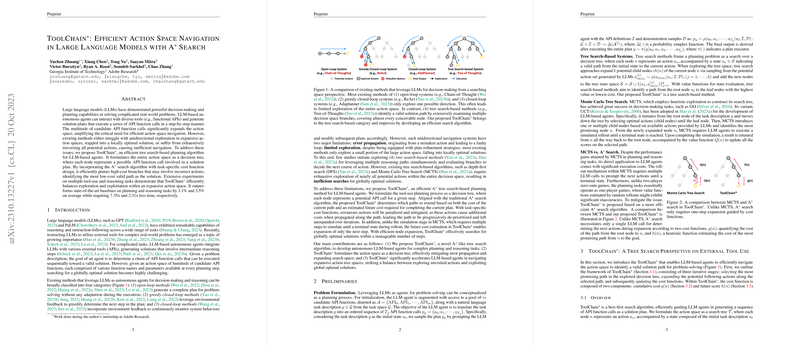Efficient Action Space Navigation in LLMs: An Examination of ToolChain
This essay discusses the paper "ToolChain: Efficient Action Space Navigation in LLMs with A Search," which explores the application of an A tree search-based planning algorithm to enhance the efficiency of LLM-based agents. LLMs, like GPT and PaLM, have extended their capabilities beyond text generation, encompassing decision-making and problem-solving across diverse domains. However, navigating the extensive action space that comes with these tasks poses significant challenges. ToolChain seeks to address such challenges by introducing an innovative solution grounded in the principles of A search.
Key Concepts and Contributions
The primary focus of ToolChain is to optimize action space navigation when LLMs interact within autonomous agent frameworks, particularly when these agents are tasked with using tools like API functions. Traditional approaches in this domain often fall into two traps. The first is becoming stuck in locally optimal solutions due to unidirectional exploration strategies, while the second is inefficiency caused by exhaustive exploration of all possible actions.
ToolChain addresses these issues by representing the entire action space as a decision tree, utilizing A search principles to explore this space. Each node in the tree represents a potential API call step, and the A algorithm aids in pruning branches unlikely to lead to a solution, thus focusing computational resources on the most promising paths. Crucially, ToolChain uses a task-specific cost function to guide this exploration, penalizing high-cost actions that represent suboptimal or incorrect paths.
Numerical Results and Performance
ToolChain underwent extensive testing on a suite of tool-use environments within ToolBench, as well as mathematical reasoning challenges from the GSM8K dataset. Empirically, ToolChain demonstrated an improved planning and reasoning success rate compared to current state-of-the-art methods, showing average performance improvements of 3.1% in planning tasks and 3.5% in reasoning tasks using fewer computational resources—specifically, achieving results in 7.35x and 2.31x less time, respectively.
The significant reduction in computational overhead is attributed to the effective search and optimization strategies inherent in ToolChain. By evaluating future costs more efficiently and narrowing down action steps without exhaustive unfolding of all possibilities (as seen in traditional MCTS approaches), ToolChain provides a balanced framework for action selection in expansive action spaces.
Practical and Theoretical Implications
The paper's contributions significantly enhance the practicality of deploying LLMs as autonomous agents in real-world applications where interactions with external tools are required. The ability to efficiently navigate and make decisions within vast action spaces without succumbing to local optima is crucial for scaling such technologies. Theoretically, the integration of A search within LLMs showcases how AI can draw across disciplines, merging insights from heuristic-based search algorithms with modern LLMs to effectively address complex tasks.
Future Directions in AI
The development of ToolChain suggests several avenues for future research. The algorithm’s reliance on task-specific heuristics invites the exploration of automated or adaptive heuristic generation methods, potentially increasing the algorithm's flexibility and applicability. Additionally, extending these strategies to multi-agent systems can offer insights into collaborative and competitive settings where multiple LLMs are engaged in concurrent or opposing objectives.
Lastly, further work can aim to generalize this framework beyond tool interaction tasks. The core principle—efficiently navigating large decision spaces—holds the potential applicability across several domains, from robotics and autonomous systems to strategic games.
In conclusion, ToolChain presents a sophisticated approach to enhancing the utility and efficiency of LLMs in complex action-driven environments. By combining tree search algorithms with modern LLMs, the research provides both empirical benefits and theoretical advancements indicative of future trends in AI research and application.
